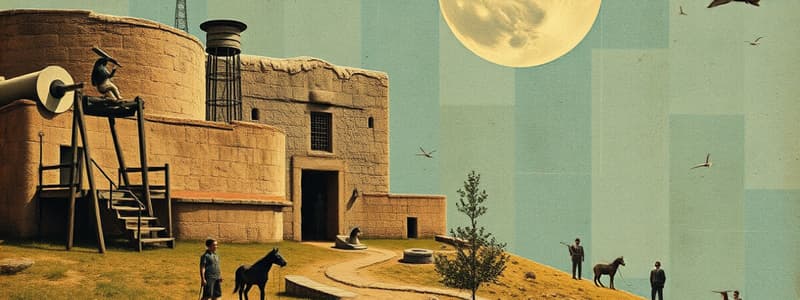Podcast
Questions and Answers
Which age is characterized by the development of agriculture and fixed settlements?
Which age is characterized by the development of agriculture and fixed settlements?
- Mesolithic Age
- Bronze Age
- Neolithic Age (correct)
- Paleolithic Age
What term refers to the giant stones used in the construction of structures like Stonehenge?
What term refers to the giant stones used in the construction of structures like Stonehenge?
- Dolmens
- Henge
- Menhir
- Megaliths (correct)
What type of structure involves a horizontal beam supported by vertical posts, commonly seen in ancient constructions?
What type of structure involves a horizontal beam supported by vertical posts, commonly seen in ancient constructions?
- Post and Lintel (correct)
- Vaulting
- Arch construction
- Dome structure
What was the primary purpose of cave paintings created by Paleolithic people?
What was the primary purpose of cave paintings created by Paleolithic people?
Which of the following sites is known for early examples of urban design, including narrow alleys?
Which of the following sites is known for early examples of urban design, including narrow alleys?
Which prehistoric construction is renowned for its astronomical correlation and has been linked to rituals?
Which prehistoric construction is renowned for its astronomical correlation and has been linked to rituals?
Which materials were commonly utilized for creating cave paintings?
Which materials were commonly utilized for creating cave paintings?
What is the significance of the walls found in early human settlements like Skara Brae?
What is the significance of the walls found in early human settlements like Skara Brae?
Flashcards are hidden until you start studying
Study Notes
Prehistory Overview
- Divided into three main epochs: Stone Age, Bronze Age, Iron Age.
- Timeline spans from 2,500,000 years ago to 1,200 BCE.
- B.C.E (Before Common Era) and C.E (Common Era) provide secular alternatives to traditional dating methods.
Stone Age Subdivisions
- Paleolithic: Also known as the Old Stone Age, marked by nomadic hunter-gatherer lifestyles.
- Mesolithic: The Middle Stone Age, characterized by transitional cultures and emerging technologies.
- Neolithic: The New Stone Age, notable for the advent of agriculture, fixed settlements, and the rise of civilizations.
Cave Art
- Cave paintings found in locations like Lascaux (France) illustrate important animal symbols, human figures, and abstract signs.
- Used natural earth tones derived from materials such as manganese, charcoal, iron oxides, and clay.
- Reflects the relationship between prehistoric humans and their environment.
Stonehenge
- Constructed between 2600-1400 BCE, known for its circle of megaliths.
- Terms:
- Henge: circular earthwork.
- Megaliths: large stones used in the construction.
- Menhir: standing stones often found in alignment with celestial events.
- Functioned as a site for rituals and pilgrimages; significant astronomical correlations noted.
Structure and Construction Techniques
- Employed the post and lintel architectural technique, also seen in ancient Roman buildings.
- The process of erecting the stones at Stonehenge is estimated to have taken around 50 years.
Early Settlements
- One of the first known settlements is Skara Brae, showcasing early urban design.
- Features narrow alleys and partitions, indicating advanced societal organization.
- Structures mainly built from stone; included embedded furniture, indicating fixed furnishings within homes.
Studying That Suits You
Use AI to generate personalized quizzes and flashcards to suit your learning preferences.




